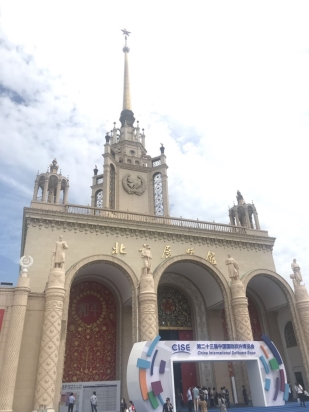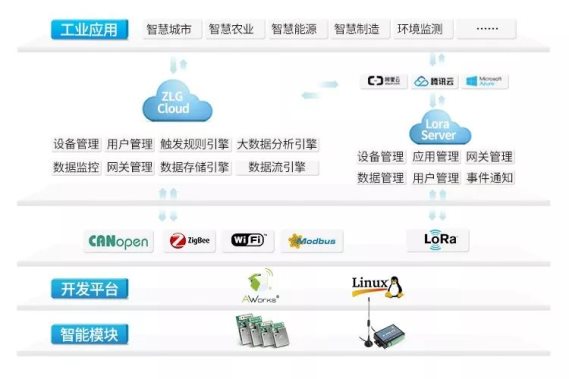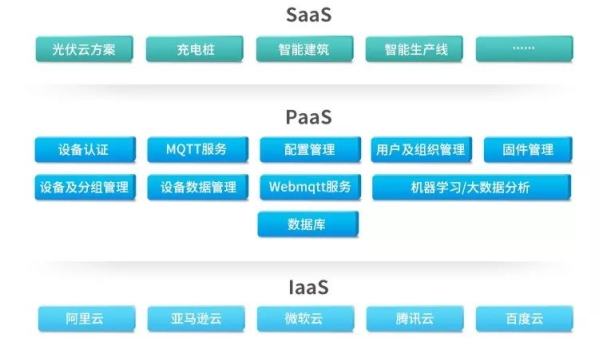The concept of the Internet of Things has been around for four or five years, and has finally accelerated recently. With the rapid development of sensor technology, communication technology, embedded technology, and distributed processing technology, the networking of information automatic generation devices and radio frequency communication devices represented by various sensors, radio frequency modules, and smart terminals together constitutes a hardware support platform for real-time and accurate perception, measurement, and monitoring of the real physical world. The Internet of Things has quickly reached every corner of society. The value of the Internet of Things cloud platform lies in that it completely breaks through the limitations of human-to-human communication on the Internet, making the interaction between people and things simpler, and even building a communication bridge between things.

At this year's China International Software Expo, a cloud platform released by a company from Guangzhou caught our eyes. In order to solve the pain points of the industry, the ZWS cloud platform launched by Ligong Technology, combining the advantages of chips and modules, is a "brain" that collects data, visualizes and controls the entire industrial intelligent IoT ecosystem, providing users with stable and reliable cloud service solutions.
What is ZWS cloud platform?
ZWS cloud platform, full name: ZLG Web Service cloud computing service platform, is an IoT cloud platform service system launched by ZLG Ligong Technology. It aims to provide devices with secure and reliable connection and communication capabilities, connect to massive devices downward, and support device data collection on the cloud; provide cloud API upward, and command data is sent to the device end through API calls to achieve remote management.
Li Baihua, Executive Vice President of Ligong Technology, introduced that the ZWS cloud platform supports the rapid access of devices with different protocols, and provides a feature-rich console system for unified management of connected devices. Without secondary development, you can easily view the data and status of the device, and remotely control the device and upgrade the firmware. In addition, for customers with existing business systems, it supports data transparent transmission to the customer's own third-party system; for customers with customized needs, it supports visual configuration programming and a complete secondary development package; for customers with high privacy requirements, it supports fully private deployment. The ZWS cloud platform supports providing one-stop solutions for customers' core needs from multiple different dimensions.

The overall system framework of the ZWS cloud platform adopts a layered collaborative design. At the hardware and system level, based on the intelligent modules and AWorks development platform of ZLG Ligong Technology, devices with different protocols can quickly access the cloud platform; at the intermediate service layer, since LoRaWAN itself has independent international standards, the ZWS cloud platform is divided into two parts: ZLG Cloud and LoRa Server. The former is responsible for providing services for general types of devices, and the latter mainly provides services for LoRaWAN type devices. These two parts can be used independently or collaboratively, and finally connected to the same application system for management.

ZWS cloud platform PaaS layer shows strength
Let me first briefly introduce the PaaS layer. With the development of the Internet of Things, basically all applications in the future will be based on the Internet of Things, and all applications in the future will be SaaS applications developed on the Internet of Things PaaS platform, so the Internet of Things PaaS platform will carry future commercial services.
At the IaaS layer, the ZWS cloud platform can use the hardware facilities provided by basic service providers such as Alibaba Cloud and Amazon Cloud as basic services. At the PaaS layer, it has achieved true independent research and development, using microservice technology, RestfulAPI interface, Docker container technology, MongoDB technology, Redis technology, distributed technology, etc., to provide users with middle-layer service interfaces such as device authentication, device management, data management, and big data analysis.

Microservice technology: Each service runs independently without interfering with each other, making the platform more stable;
·RestfulAPI interface: unified API interface format to facilitate secondary development;
Docker container technology: more convenient to deploy, improving the efficiency of distributed deployment and private deployment;
MongoDB technology: database storage technology, with higher efficiency in storing and reading big data;
Redis technology: a high-performance key-value database used as a cache service to improve server performance;
Distributed technology: multiple servers run in parallel to improve the efficiency of multi-node concurrent operation.
Strive to be an expert in a small but specialized vertical field
For the infrastructure layer (IaaS), Ligong Technology will also cooperate with public clouds. Li Baihua, executive vice president of Ligong Technology, said: "Some large public clouds are huge in scale, and there are also small companies that launch various clouds. But the architecture is similar, the only difference is at the PaaS level. From the PaaS content, it can be seen that the modules at the PaaS level of most public clouds are basically divided according to industry areas. Their positioning and planning directions are different, and ZWS is mainly aimed at vertical sub-sectors in the industrial field. To put it more vividly, those large public cloud companies have to build skyscrapers, and ZWS only needs to build a small commercial building.
AWTK is the next generation open source GUI engine
AWTK (Toolkit AnyWhere) is a C-based GUI framework developed by ZG. It aims to provide a powerful, efficient and reliable GUI engine that can easily create highly fluent and interactive interfaces. It also pioneered cross-platform synchronous development, achieving one-time programming and lifelong use.
With the popularity of portable devices such as mobile phones and smart watches, users have higher and higher requirements for human-computer interaction interfaces (GUIs). Embedded systems are in urgent need of an efficient GUI engine that can provide engineers with the tools required for various GUI designs and quickly create powerful and interactive GUI interfaces without starting from scratch. To this end, ZLG launched the open source GUI engine AWTK.

It can be said that the AWTK engine is a bridge between UI and background program development, which provides users with a new upgrade in vision and experience while optimizing the background algorithm. Ligong Technology has a dedicated UI team to design the interface, and the code algorithm is done by engineers in the background. The AWTK engine supports the two, and commercial free is also a highlight of Ligong Technology.
In addition, in terms of 5G strategy, Ligong Technology, as a 5G infrastructure application manufacturer, will help the development of 5G and provide related communication equipment and infrastructure services.
Just to change a small part of the world
Ligong Technology has more than 20 years of experience in hardware research and development. Their aim is to make users feel simple, convenient and efficient when entering the ZWS cloud platform, and to minimize the difficulty of user development. They aim to establish a systematic and integrated service solution from data collection, data transmission, data processing to the cloud platform. Based on this, they spent 2 years of hard work to develop the ZWS cloud platform.
In addition, Ligong Technology controls key core technologies such as high-precision data acquisition, fieldbus, and embedded control, and provides an industrial intelligent Internet of Things ecosystem from "chip" to "cloud". It has unique vertical industrial chain integration capabilities, outputs overall solutions and services to users, and provides maximum value.

Li Baihua talked about the future direction and difficulties of today's IoT cloud technology. The difficulty of cloud platform development is well known. In the future, a complete and systematic solution will be proposed for industry users. Therefore, Ligong Technology will not take the big and broad route like other companies. It is wise to start from a small and specialized vertical industry. Only in this way can we move from single-point cooperation to systematization. In addition, the biggest advantage of Ligong Technology is that they have 20 years of hardware development experience, so the integration ability of vertical industries can be said to be among the best.
Previous article:Qualcomm and ZTE Collaborate to Expand 5G Cloud Gaming Use Cases Based on Live Network Environments
Next article:Technical Article—What is the difference between 5G SA and NSA?
Recommended ReadingLatest update time:2024-11-15 15:04

- e-Network Community and NXP launch Smart Space Building Automation Challenge
- The Internet of Things helps electric vehicle charging facilities move into the future
- Nordic Semiconductor Launches nRF54L15, nRF54L10 and nRF54L05 Next Generation Wireless SoCs
- Face detection based on camera capture video in OPENCV - Mir NXP i.MX93 development board
- The UK tests drones equipped with nervous systems: no need to frequently land for inspection
- The power of ultra-wideband: reshaping the automotive, mobile and industrial IoT experience
- STMicroelectronics launches highly adaptable and easy-to-connect dual-radio IoT module for metering and asset tracking applications
- This year, the number of IoT connections in my country is expected to exceed 3 billion
- Infineon Technologies SECORA™ Pay Bio Enhances Convenience and Trust in Contactless Biometric Payments
- LED chemical incompatibility test to see which chemicals LEDs can be used with
- Application of ARM9 hardware coprocessor on WinCE embedded motherboard
- What are the key points for selecting rotor flowmeter?
- LM317 high power charger circuit
- A brief analysis of Embest's application and development of embedded medical devices
- Single-phase RC protection circuit
- stm32 PVD programmable voltage monitor
- Introduction and measurement of edge trigger and level trigger of 51 single chip microcomputer
- Improved design of Linux system software shell protection technology
- What to do if the ABB robot protection device stops
- Analysis of the application of several common contact parts in high-voltage connectors of new energy vehicles
- Wiring harness durability test and contact voltage drop test method
- From probes to power supplies, Tektronix is leading the way in comprehensive innovation in power electronics testing
- From probes to power supplies, Tektronix is leading the way in comprehensive innovation in power electronics testing
- Sn-doped CuO nanostructure-based ethanol gas sensor for real-time drunk driving detection in vehicles
- Design considerations for automotive battery wiring harness
- Do you know all the various motors commonly used in automotive electronics?
- What are the functions of the Internet of Vehicles? What are the uses and benefits of the Internet of Vehicles?
- Power Inverter - A critical safety system for electric vehicles
- Analysis of the information security mechanism of AUTOSAR, the automotive embedded software framework
- The use of SRAM in HPM6750 and the problems encountered
- Oscilloscope automobile turbocharger solenoid valve waveform and analysis
- Transformer voltage calculation
- Failure to send data in broadcast mode
- EEWORLD University - IGBT module technology, drive and application
- Mbed online compiler to be retired soon
- New China Mobile Onenet NB Development Board
- PicoPlanet – Development board with capacitive touch
- Looking for the distributor of Sonix SN8P2501DSG chip
- 【Qinheng CH582】2, Compilation environment + the first LED program

 Internet of Things. Systems Design. Lab Book (Charith Perera)
Internet of Things. Systems Design. Lab Book (Charith Perera)












 京公网安备 11010802033920号
京公网安备 11010802033920号